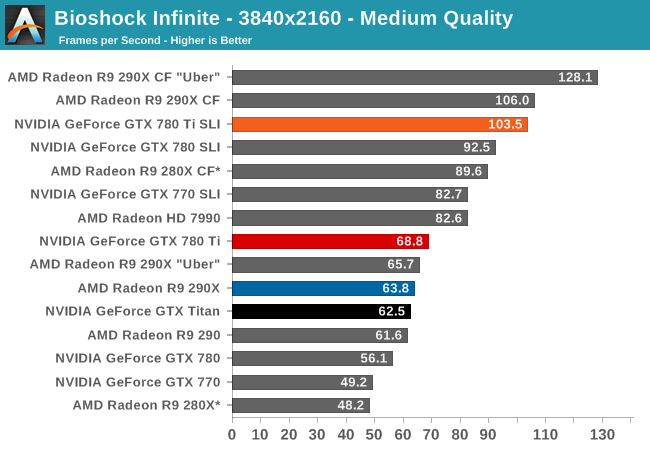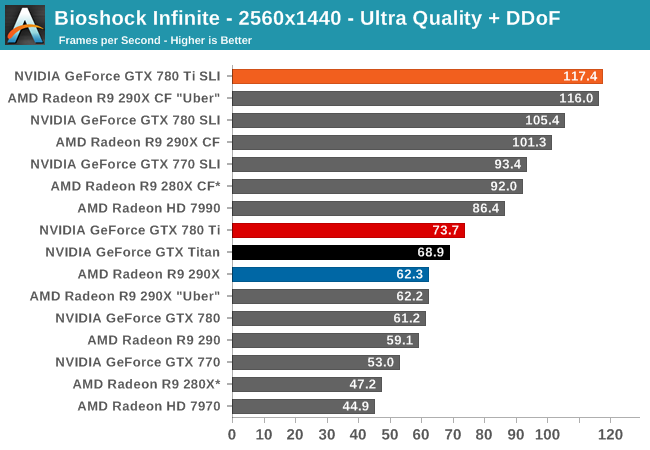The NVIDIA GeForce GTX 780 Ti Review
by Ryan Smith on November 7, 2013 9:01 AM ESTBioshock Infinite
Bioshock Infinite is Irrational Games’ latest entry in the Bioshock franchise. Though it’s based on Unreal Engine 3 – making it our obligatory UE3 game – Irrational had added a number of effects that make the game rather GPU-intensive on its highest settings. As an added bonus it includes a built-in benchmark composed of several scenes, a rarity for UE3 engine games, so we can easily get a good representation of what Bioshock’s performance is like.



As opposed to our previous game, with Bioshock the GTX 780 Ti comes out at a very strong contender, easily surpassing everything AMD and NVIDIA. Here we see it best AMD’s best by 18%, and against GTX Titan and GTX 780 it’s 7% and 20% ahead respectively. Though admittedly everything here is averaging better than 60fps at this point.
Meanwhile for the AFR matchup, with a pair of GTX 780 Ti’s we’re either looking framerates that will make a 120Hz gamer happy, or enough horsepower to take on 4K at our highest settings and still come out well ahead. At 57.3fps the GTX 780 Ti is several frames per second ahead of the 290X CF, coming up just short of averaging 60fps even at this very high resolution.










302 Comments
View All Comments
1Angelreloaded - Thursday, November 7, 2013 - link
Physically the 780 and 780 TI are literally the same unit, minus minor things. The difference is the neutered chip, and OC'd VRAM, Which means your paying for the same unit at 2 completely different prices, in fact, How much does it cost to disable the SMX texture? So shouldn't the overhead on the original unit be higher with more work having to be done? Or like AMD tricore are we paying for defective chips again ?TheJian - Thursday, November 7, 2013 - link
Wrong. They have been saving DEFECT FREE GK110 units for months just to be able to launch this with good quantity (probably only started having better results at B1, which all of these are). I doubt that there are many 780's that have fully working units that are disabled. They are failed Tesla chips (you can say DP is disabled on purpose, but not the SMX's). Do you really think 550mm chips have a ZERO defect rate?...LOL. I would be surprised if the first runs of Titan had any more working SMX's too as they were directly failed Tesla's. Sure there are probably a few cards with some working that are disabled but Yields and history say with chips this big there just has to be a pretty high defect rate vs. 100% working chips. It is pretty much the largest chip TSMC can make. That's not easy. Both AMD and NV do this to salvage failed chips (heck everybody does). You come with a flagship, then anything that fails you mark as a lower model (many models). It allows you to increase your yield and chips that can be sold. You should be thankful they have the tech to do this or we'd all be paying FAR higher prices do to chucking chips by the millions in the trash.TheJian - Thursday, November 7, 2013 - link
http://www.tomshardware.com/reviews/geforce-gtx-78..."Not to be caught off-guard, Nvidia was already binning its GK110B GPUs, which have been shipping since this summer on GeForce GTX 780 and Titan cards. The company won’t get specific about what it was looking for, but we have to imagine it set aside flawless processors with the lowest power leakage to create a spiritual successor for GeForce GTX 580. Today, those fully-functional GPUs drop into Nvidia’s GeForce GTX 780 Ti."
There, don't have to believe me...confirmed I guess ;)
beck2448 - Thursday, November 7, 2013 - link
Great job Nvidia! I think the partners with custom cooling will get another 15 to 20 % performance out of it with lower temps and less noise, and that is insane for a single GPU. Can't wait to see the Lightning and Windforce editions.aznjoka - Thursday, November 7, 2013 - link
The crossfire scaling on the 290x is much better than the 780ti. If you are running a dual card set up, getting a 290x is pretty much a no brainer.beck2448 - Thursday, November 7, 2013 - link
from Benchmark reviews: In conclusion, GeForce GTX 780 Ti is the gamer’s version of GTX TITAN with a powerful lead ahead of Radeon R9 290X. Even if it were possible for the competition to overclock and reach similar frame rate performance, temperatures and noise would still heavily favor the GTX 780 Ti design. I was shocked at how loud AMD’s R9 290X would roar once it began to heat up midway through a benchmark test, creating a bit of sadness for gamers trying to play with open speakers instead of an insulated headset. There is a modest price difference between them, but quite frankly, the competition doesn’t belong in the same class.Read more at http://benchmarkreviews.com/8468/nvidia-geforce-gt...
1Angelreloaded - Thursday, November 7, 2013 - link
TBH the stock Nvidia cooler isn't that much better either they tend to run a lot hotter than ACX/Twin Frozer, and other such solutions, so both have cooling headroom, Hawaii though is just plain ridiculous.deedubs - Thursday, November 7, 2013 - link
Noticed the graph for shadowplay performance has its labels reversed. It makes it look like SP increases performance instead of decreasing.Ryan Smith - Thursday, November 7, 2013 - link
Whoops. Thanks for that. The multi-series graph tool is a bit picky...Filiprino - Thursday, November 7, 2013 - link
I don't see NVIDIA as a real winner here, really. Their margin is very tight, and AMD drivers still have to mature, and when you talk about crossfire, AMD is doing clearly better, for $200 less and 6dB more.